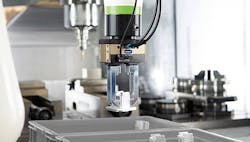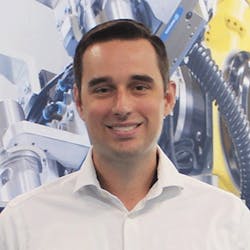Aaron Royster is product manager at Schunk in Morrisville, North Carolina.
Tell us about your company’s state-of-the-art robotics technology.
Aaron Royster, product manager, Schunk: Schunk is an industry leader in end-of-arm tooling with a core focus of grasping and handling workpieces. Standard gripping components are highly optimized in their design to perform the stringent tasks required to function on the end of robots. Mechanics must be strong to support a wide range of workpiece sizes, shapes and mass, while also remaining lightweight and compact to not overburden the robot. These proven components must endure a wide range of environments from clean rooms to furnaces. Finally, components need to be easy for the user to integrate. Flexibility in mounting and custom tooling adaptations is key to fast and successful robot deployments. The new PGL-plus-P pneumatic gripper from Schunk is a great example of a flexible, lightweight and easy-to-integrate end-of-arm tool. With benefits like integrated full-stroke sensing with IO-Link communication and certified grip force maintenance maintaining 80% of grip force under pressure loss, advancing robotics technology is benefiting the industry and end users of the components.
Also read: Autonomous mobile robots’ value is more than just speed
What have been the biggest improvements to robotics technology in the past five years?
Aaron Royster, product manager, Schunk: Robots are constantly improving, becoming faster and stronger, and offering features allowing users to easily integrate for specialized tasks. More manufacturing companies look to robots to ease pressures of labor shortage and supply-chain dependability. Many of these new users of automation struggle to gain the needed confidence and technical experience. Robot producers are answering the call by making their equipment more intuitive during setup and programing. There is a vast support network developing standardized mechanical and software solutions, similar to mobile phone applications, that support the fast and easy deployment of robots.
What’s the most innovative or efficient robotics technology application you’ve ever seen or been involved with?
Aaron Royster, product manager, Schunk: There are many interesting cases from which to choose, but machine learning has to be toward the top. Combining vision technology, flexible gripping mechanics—like a human hand is flexible—and AI, wide ranges of unstructured workpieces can be handled reliably and even improve over time. This brings much needed automation into intralogistics, food handling and other nontraditional robot use.
How has robotics technology benefitted from remote monitoring and connectivity?
Aaron Royster, product manager, Schunk: No automation solution is perfect. When you are in school and achieve 99/100 on a test, you get an A+ and feel accomplished because you scored nearly perfect. In automation, 99% success rate is usually a failing grade. Remote monitoring can offer quick recovery for when an automation system stalls. Another benefit is flexibility. Remote access enables manufacturing managers to make on-the-fly decisions to command automation systems to adapt to changing demands. Tooling and process changes can be made to accommodate new infeed of workpieces to be processed. Advanced sensing technologies have been combined with remote monitoring software to take remote monitoring and connectivity to the next level. Software identifies where a robot is planned to be at any given point in an automated process and alarms if anything occurs to move the point outside of an allowable tolerance. One task where this technology is extremely useful is welding. Automated welding applications are not new, but tracking each weld remotely with pinpoint accuracy to ensure the exact position is achieved is a new and exciting application in remote monitoring and connectivity.
Can you explain how software development has changed robotics technology design and production?
Aaron Royster, product manager, Schunk: Software development greatly improves connectivity of robots to the processes they serve and also enhances those process. For example, a robot tending a milling machine has to interface with the machine and all the peripheral components such as end-of-arm tooling, workpiece conveying systems or safety equipment. Software is greatly simplifying these device connections and shortening the time for successful deployments and redeployments. Application software aids the users with short cuts for organizing common robot path routines.
How do robotics technologies figure into digital-twin platform models being used by manufacturer?
Aaron Royster, product manager, Schunk: One of the worst things that can happen when investing in new automation is to purchase and build the equipment only to discover you cannot perform the necessary task due to physical interferences or cycle times being unmet. Digital twin and other simulation tools are an excellent way to work through challenges ahead of time, when they are small and more easily solvable. These tools can also be used for advanced planning to account for future changes to automation.
When will robotics technology become IT-friendly enough that engineers are no longer required for installation and operation?
Aaron Royster, product manager, Schunk: There will always be situations where engineers and other technical experts are needed for robot advanced-use cases. Some examples of those today include polishing and fine material removal application, painting, welding and complex workpiece assembly tasks. Simple and routine tasks are already becoming possible for novice users and will continue to accelerate. Applications that are complex today will continue to open up to the novice user while new frontiers will be opened by the advanced user.
What future innovations will impact the use of robotics technology in discrete-manufacturing operations?
Aaron Royster, product manager, Schunk: From the standpoint of an end-effector company, we will continue to see multiple technologies developed and combined together to make standard highly engineered solutions for robot users. If we look back at some of the first robot grippers ever made, a guidance, force-producing component and mounting were offered in a single end-of-arm tool. Today, advanced sensing, vision, mechatronic components and software is integrated together with a gripper as a single end-of-arm tool. This brings innovation and value to the end user with standard or configurable tool offerings to avoid reengineering solutions for problems that have already been solved.
Mike Bacidore is the editor in chief for Control Design magazine. He is an award-winning columnist, earning a Gold Regional Award and a Silver National Award from the American Society of Business Publication Editors. Email him at [email protected].
About the Author
Mike Bacidore
Editor in Chief
Mike Bacidore is chief editor of Control Design and has been an integral part of the Endeavor Business Media editorial team since 2007. Previously, he was editorial director at Hughes Communications and a portfolio manager of the human resources and labor law areas at Wolters Kluwer. Bacidore holds a BA from the University of Illinois and an MBA from Lake Forest Graduate School of Management. He is an award-winning columnist, earning multiple regional and national awards from the American Society of Business Publication Editors. He may be reached at [email protected]

Leaders relevant to this article:



